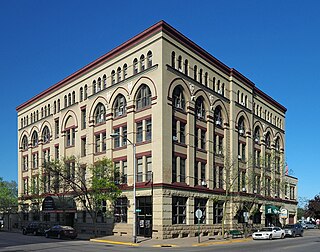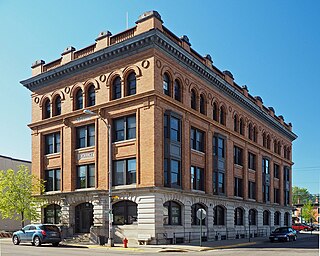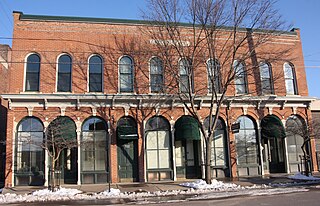
Whitewater State Park is a state park of Minnesota, United States, preserving a stretch of the Whitewater River surrounded by rocky bluffs. It is located in Winona County in the southeastern blufflands area of the state. The 2,700-acre (11 km2) park features scenic overlooks and trout fishing in the spring-fed Whitewater River and Trout Run Creek. It has about 300,000 visitors annually, and is located 7 miles (11 km) north of St. Charles on Minnesota State Highway 74, which runs through the park.

The Winona County Courthouse is the seat of government for Winona County in Winona, Minnesota, United States. The 1889 Richardsonian Romanesque building was listed on the National Register of Historic Places in 1970 for having local significance in the themes of architecture, art, and politics/government. It was nominated for being an artistic manifestation of Winona's prosperous riverboat and logging era. It was the first courthouse in Minnesota listed on the National Register.

This is a list of the National Register of Historic Places listings in Winona County, Minnesota. It is intended to be a complete list of the properties and districts on the National Register of Historic Places in Winona County, Minnesota, United States. The locations of National Register properties and districts for which the latitude and longitude coordinates are included below, may be seen in an online map.

The Winona Public Library is the public library serving Winona, Minnesota, United States. It is a member of Southeastern Libraries Cooperating, a Minnesota library region. Housed in an 1899 Neoclassical building, the Winona Public Library was listed on the National Register of Historic Places in 1977 for having local significance in architecture and education. It is Minnesota's oldest library to continuously operate in a purpose-built facility.

The Duluth Civic Center Historic District is a historic government complex in Duluth, Minnesota, United States. It includes the St. Louis County Courthouse, Duluth City Hall, and the Gerald W. Heaney Federal Building. The complex was designed by urban planning pioneer Daniel Burnham in 1909 and constructed over the next twenty years. It was listed as a historic district on the National Register of Historic Places in 1986 for its state-level significance in the themes of architecture and community planning and development. It was nominated for its associations with Burnham and the City Beautiful movement.

The Winona Hotel is a former hotel building in Winona, Minnesota, United States, constructed in 1889. It was listed on the National Register of Historic Places in 1983 for having local significance in the themes of architecture and commerce. It was nominated for its locally distinctive Romanesque Revival architecture and origin as a hotel specifically constructed to accommodate out-of-town visitors during Winona's heyday as a fine theatre destination. The Winona Hotel is also a contributing property to the Winona Commercial Historic District. Now known as The Kensington, the building has been converted to senior apartments.

Pickwick Mill is a historic gristmill in the unincorporated community of Pickwick, Minnesota, United States, near the city of Winona. It was constructed in the mid-1850s and is now operated as a milling museum. Pickwick Mill was listed on the National Register of Historic Places in 1970 for having state-level significance in the themes of agriculture, architecture, and industry. It was nominated for being one of southeast Minnesota's oldest surviving water-powered mills, serving as a key local industry in its day and a Winona County landmark to the present.

Trinity Episcopal Church is a historic church building in St. Charles, Minnesota, United States, constructed in 1874. It was listed on the National Register of Historic Places in 1984 for having local significance in the theme of architecture. It was nominated for the high integrity of its Carpenter Gothic design, well preserved in both the exterior and interior.
The Winona and St. Peter Railroad was a railroad in the Midwestern United States. It was founded in 1861 in Winona, Minnesota. Five years later its track reached Owatonna, Minnesota, connecting with the main line of the Minnesota Central Railroad between Chicago and Minneapolis–Saint Paul. The following year, 1867, the Chicago and North Western Transportation Company purchased the Winona and St. Peter but continued to operate it under its original name until 1900.

The historic Howard Lake City Hall is a multipurpose government building in Howard Lake, Minnesota, United States, built in 1904. It originally housed the city's government offices, post office, public library, fire department, and public meeting hall. In the 1930s the city began operating a municipal liquor store in the building, which remains the building's primary use today as most other functions have moved to newer facilities. The Howard Lake City Hall was listed on the National Register of Historic Places in 1979 for having local significance in the themes of architecture and politics/government. It was nominated as an example of early-20th-century small-town government architecture, and as Howard Lake's most prominent building.

The Winona Savings Bank Building, now the Winona National Bank Historic Downtown Building, is an Egyptian Revival bank building in Winona, Minnesota, United States. It was designed by Chicago-based architect George W. Maher and constructed from 1914 to 1916. The building was listed on the National Register of Historic Places in 1977 for having state-level significance in the themes of architecture and commerce. It was nominated for being the largest and best preserved of Minnesota's few early-20th-century Egyptian Revival buildings, and one of Maher's master works in the state.

The Old Winona Middle School is a former school complex in Winona, Minnesota, United States. The east building was originally constructed as the Winona High School from 1915 to 1917 and the west building was added as the Winona Junior High School in 1926. An auditorium was added to the rear of the east building in 1928. The property was listed on the National Register of Historic Places as the Winona High School and Winona Junior High School in 2004 for having local significance in the theme of education. It was nominated for representing local efforts to implement progressive educational trends in updated facilities, while offering cultural experiences to the wider community through professional music performances in the auditorium.

The Winona Commercial Historic District comprises six downtown blocks along 3rd Street in Winona, Minnesota, United States. It comprises 65 contributing properties mostly built in the 1880s and 1890s. The district was listed on the National Register of Historic Places in 1998 for having local significance in the theme of commerce. It was nominated for reflecting the prosperity of a river and rail town that grew into southeast Minnesota's leading commercial center of the late 19th century.

The Winona and St. Peter Railroad Freight House is a former freight house in Winona, Minnesota, United States. Built from 1882 to 1883, it is the city's last surviving freight facility of the Winona and St. Peter Railroad. The building was listed on the National Register of Historic Places in 1984 for having local significance in the theme of transportation. It was nominated as a symbol of the Winona and St. Peter Railroad, which was instrumental in spurring Winona's industry and growth by developing markets along its rail lines across Minnesota and into Dakota Territory.

Jefferson Elementary School is an elementary school in Winona, Minnesota, United States. Its building was completed in 1938, the last of five new facilities built by Winona Public Schools in the early 20th century. It was listed on the National Register of Historic Places in 2012 for its local significance in the themes of architecture and education. It was nominated for representing the efforts of Winona Public Schools to implement progressive educational reforms, as well as for its Public Works Administration funding and Art Moderne architecture.

The Grain and Lumber Exchange Building is a historic office building in Winona, Minnesota, United States. It was designed in Renaissance Revival style by the architectural firm of Kees & Colburn and built in 1900. The building was listed on the National Register of Historic Places in 1977 for its local significance in the theme of architecture. It was nominated for being among Winona's most architecturally distinctive office buildings from the turn of the 20th century. It is also notable for being designed to the specifications of its first tenants even though they were primarily renters rather than owners.

The Benjamin Ellsworth House is a historic house in Utica, Minnesota, United States. It was built in 1873 for Benjamin Ellsworth (1826–1890), the founder of Utica. The building was listed on the National Register of Historic Places in 1984 for its local significance in the themes of architecture and exploration/settlement. It was nominated for its associations with Ellsworth and for the degree of preservation of its original design.

Anger's Block is a historic commercial building in Winona, Minnesota, United States. Built in 1872, it is one of the oldest surviving commercial buildings in Winona's central business district. The building was listed on the National Register of Historic Places in 1978 for its local significance in the theme of architecture. It was nominated for its early status among Winona's downtown buildings, which is furthered by the survival of its original architectural plans. In 1998 the building was also listed as a contributing property to the Winona Commercial Historic District.

Appleton City Hall is a historic municipal building in Appleton, Minnesota, United States. It was built in 1895 as one of the few monumental 19th-century buildings in rural western Minnesota. It initially housed Appleton's government offices, fire department, and jail on the ground floor and an auditorium on the upper floor. The city hall was listed on the National Register of Historic Places in 1977 for having local significance in the themes of architecture and politics/government. It was nominated for supposedly being an example of Richardsonian Romanesque architecture and for its long service as a local government and community center. However other sources describe the building's style less specifically as Romanesque Revival, and its municipal services relocated to other facilities in 1976.

Hibbing City Hall is the seat of local government for Hibbing, Minnesota, United States. It was built in Colonial Revival style in 1922. Hibbing City Hall was listed on the National Register of Historic Places in 1981 for its state-level significance in the themes of architecture and politics/government. It was nominated for being one of northern Minnesota's most architecturally distinctive public buildings and the longstanding seat of government for one of the largest communities of the Iron Range.























